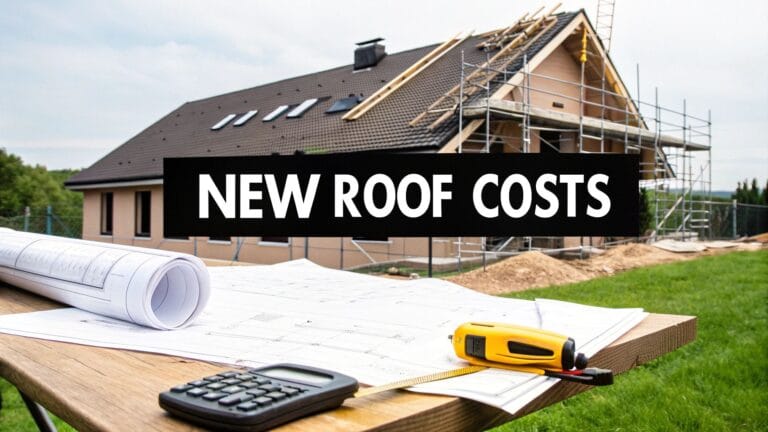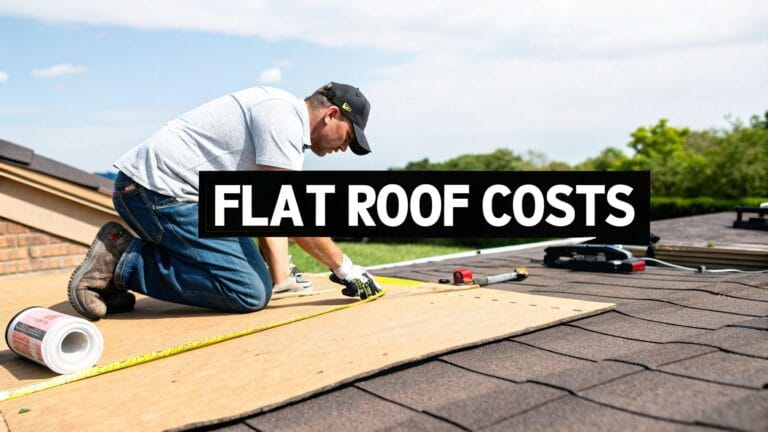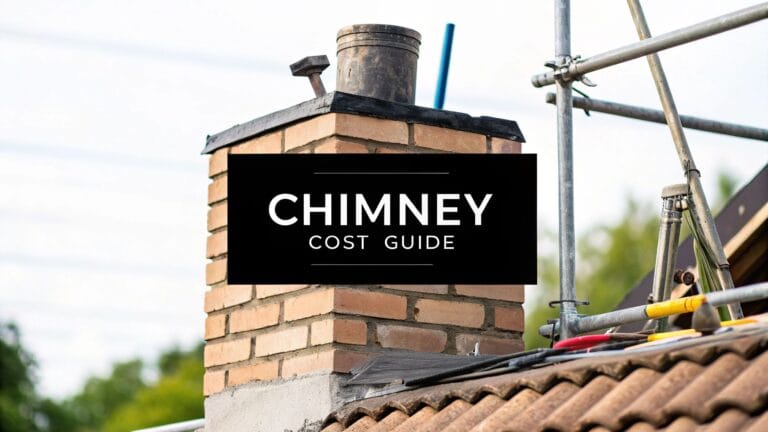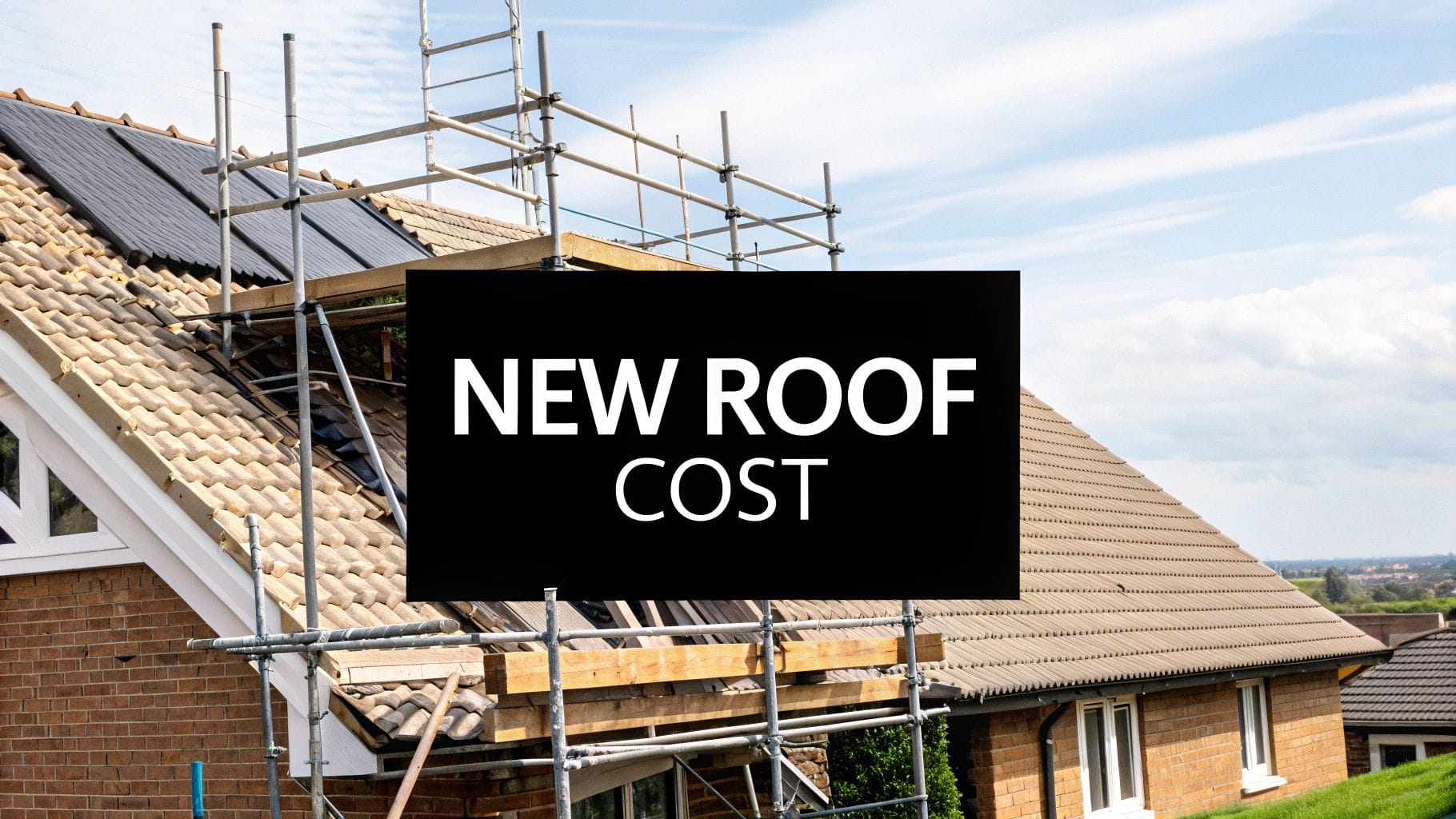
UK New Roof Cost Guide: Find the Approximate Cost of a New Roof
Looking to budget for a new roof? Discover the approximate cost of a new roof in the UK, with insights into material options and hidden costs. Get informed today!
If you're thinking about replacing your roof, the first question that probably springs to mind is, "How much is this going to cost?" It's the big one, and rightly so. For a standard three-bedroom semi-detached house in the UK, you can generally expect the cost of a new roof to be somewhere between £4,250 and £6,250.
Most projects we handle at Evershield Roofing land around the £5,250 mark, which gives you a realistic ballpark figure to start planning your budget.
Your Quick Guide to New Roof Costs in the UK
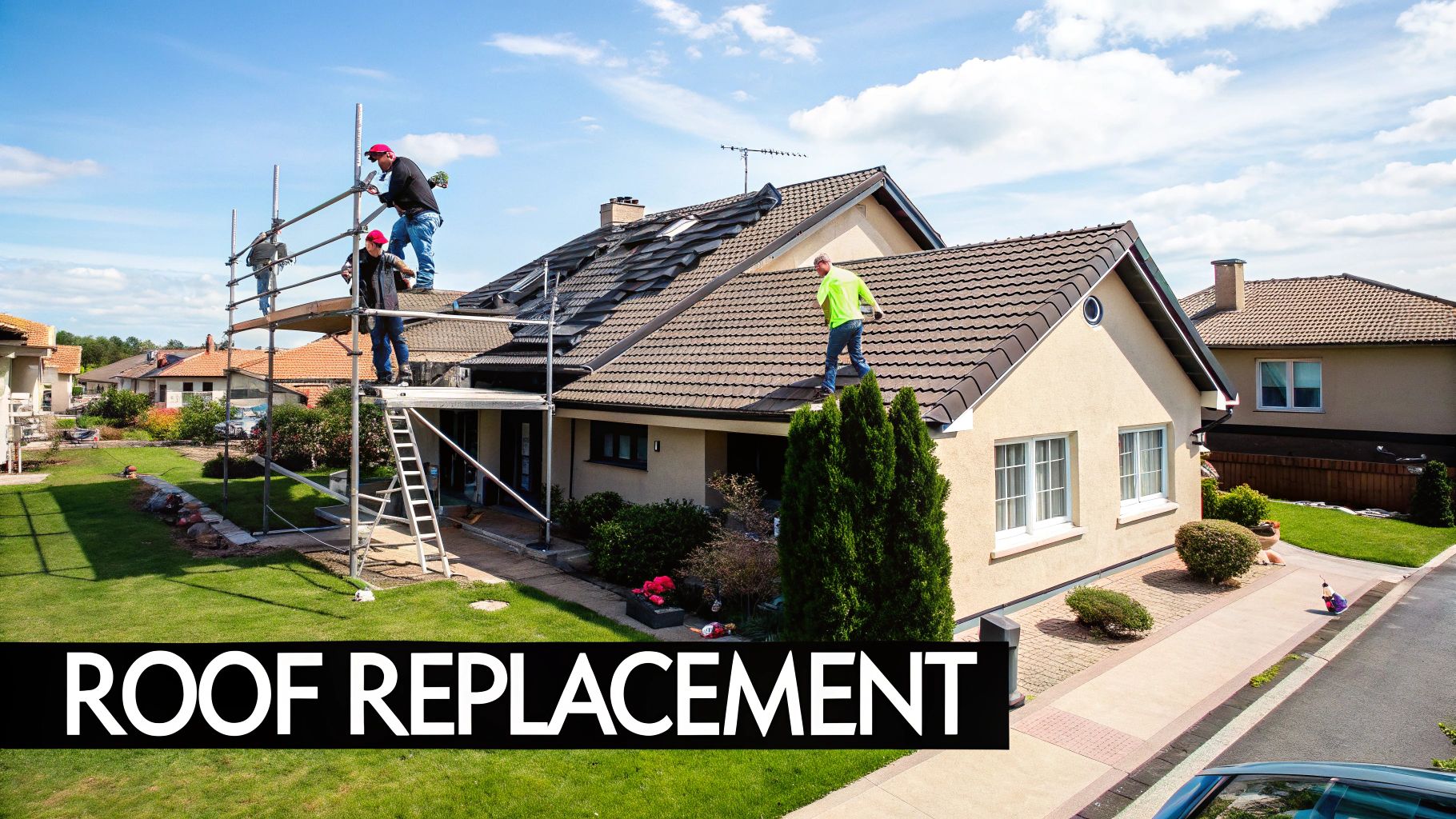
Think of that average cost as the starting point on a map. It shows you the general destination, but the exact route you take will determine the final price. Just like no two homes are identical, no two roofing quotes will be either. Every property has its own quirks and requirements.
Here at Evershield Roofing, we're all about being upfront and clear from day one. That initial price range is a great guide, but several key factors will shape the final figure to fit your specific home.
To give you a clearer picture, here's a quick summary of what you might expect to pay for a new roof on a typical UK home.
At-a-Glance New Roof Costs for a Standard UK Home
This table breaks down the potential costs for a new roof on a standard 3-bed semi-detached house, showing what you might get at different price points.
| Cost Bracket | Estimated Price Range (£) | Typical Scenario |
|---|---|---|
| Lower-End | £4,250 – £5,000 | A straightforward roof replacement using standard, budget-friendly materials. |
| Average | £5,000 – £5,500 | A quality replacement with good-grade materials and potentially minor structural work. |
| Higher-End | £5,500 – £6,250+ | A complex roof design, use of premium materials like slate, or significant repairs. |
These figures help put the national average into context, but the real drivers behind your quote come down to the specifics of your project.
Key Factors That Influence the Final Price
To truly get a handle on your potential investment, you need to look past the averages and understand what really moves the needle on price. These are the three biggest factors that can push a quote up or down.
- Roofing Materials: This is one of the biggest cost drivers. Your choice of tile makes a huge difference. Standard concrete tiles are a solid, cost-effective option, whereas beautiful natural slate or traditional handmade clay tiles sit at the premium end of the market.
- Roof Size and Complexity: It's simple, really. A basic, single-pitched roof is much faster and therefore cheaper to replace than a complicated one with multiple valleys, dormer windows, or chimneys to work around. Features like roof terraces also significantly change the scope and budget, and you can learn more about the costs associated with roof terraces here.
- Your Location: Where you live matters. Labour rates and even the cost of getting materials to site can vary quite a bit across the UK. A job in a home county like Buckinghamshire might be priced very differently from the exact same project in another part of the country.
Getting your head around these variables is the first, most important step towards building an accurate budget. When you understand what drives the price, you can have much better conversations with our team and make choices that work for your wallet.
This overview should give you a solid foundation. As we go on, remember that nothing beats a professional survey from Evershield Roofing for getting a precise, fixed quote that’s tailored to your home. We'll explore all these cost factors in more detail throughout this guide, so you can plan your new roof with complete confidence.
Decoding Your Roofer's Quote
When roofing quotes land on your doormat, it can feel like you’re trying to compare apples and oranges. Why is one thousands of pounds more than another for what seems like the same job? It’s because a good quote isn’t just a number; it’s a full project plan, and the devil is always in the detail. Getting your head around these details is the only way to truly understand the approximate cost of a new roof for your home.
Think of a quote as more than just the price of tiles and labour. It's the blueprint for getting the job done safely, legally, and to a standard that will last for decades. When you get a quote for a new roof, understanding what goes into it and the various factors influencing installation costs will help you see the full picture.
The Impact of Roof Complexity and Pitch
One of the biggest cost drivers is simply how complicated your roof is. A straightforward, rectangular gable roof – the classic two-sided shape you see on many semi-detached houses – is relatively easy work for a good team. The job flows, and there are few fiddly bits to slow things down.
The moment you add more complex features, however, the labour and material costs start to creep up.
- Valleys and Hips: These are the internal and external corners where different sections of your roof meet. Every single one needs precise cutting and specialised waterproofing, which uses more time and more materials.
- Dormer Windows: Each dormer is essentially a tiny roof on its own, complete with its own flashing, side panels (cheeks), and roofing. Working around them is a skilled job that you can't rush.
- Chimneys and Skylights: Anything that pokes through the roofline needs to be meticulously sealed and flashed to keep water out. This is precision work, and it all adds hours to the job.
The pitch, or steepness, of your roof also plays a massive part. A low-pitched roof is a much safer and easier place for a roofer to work. As the roof gets steeper, the risk increases, often demanding extra safety gear and more complex scaffolding. Naturally, this adds to the project cost.
A detailed quote should reflect this. If you have a complex roof with multiple dormers and a steep pitch, you should expect the labour costs to be significantly higher than for a simple, low-pitched roof of the exact same size. This isn’t a contractor trying to pull a fast one; it’s them pricing for the skill and time needed to deliver a professional, watertight finish.
Site Access and Logistical Challenges
This is the one homeowners often forget. Where your house is and how easy it is to get to the roof can have a surprising impact on the final price.
Picture a detached house with a big drive and garden. Access is a dream. We can store materials on-site, get a skip right where we need it, and put up scaffolding without any fuss. It’s the ideal scenario.
Now, imagine a terraced house on a tight street with no front garden or parking. Suddenly, the job is full of logistical hurdles:
- Scaffolding: It might need a special licence from the local council if it has to go over a public pavement.
- Material Delivery: All those heavy tiles might need to be carried through your house or lifted over neighbouring buildings.
- Waste Disposal: The skip might have to go on the road, which again means getting a permit and sometimes even arranging traffic management.
These challenges add time, admin, and labour costs to the project, and any professional quote will have to account for them.
The Itemised Breakdown: What to Look For
A transparent, trustworthy quote will never just be a single figure scribbled on a piece of paper. It should be a clear, itemised list that breaks down every single cost.
Here’s what you should be looking for:
- Labour Costs: The price for the skilled team doing the work.
- Materials: A detailed list covering everything from the tiles or slates to the underlay, battens, nails, and membranes.
- Scaffolding: The cost for hiring, putting it up, and taking it down.
- Waste Disposal: The price of skip hire and responsibly getting rid of all the old materials.
- Structural Checks/Repairs: An allowance for fixing any rotten timbers or damaged structures found underneath the old roof.
- Additional Items: Separate costs for any new fascias, soffits, guttering, or chimney work if you’ve asked for it.
Learning how to read these quotes properly is a skill. For more practical tips, have a look at our guide on choosing the right contractor for your new roof and key questions to ask. By understanding these moving parts, you can compare quotes like-for-like and make a decision you feel confident about.
Choosing Your Roofing Materials Wisely
Without a doubt, the material you pick is the single biggest factor driving the cost of a new roof. It’s a decision that goes far beyond the initial price tag. It shapes your home's entire look, its ability to stand up to the notoriously fickle UK weather, and how many years will pass before you even have to think about this job again. It’s all about balancing your immediate budget with long-term value.
Here at Evershield Roofing, we guide homeowners across Buckinghamshire and the surrounding areas through this exact decision every single day. We understand the trade-offs, from a practical, budget-friendly concrete tile on a modern home to the beautiful Welsh slate often required for period properties in conservation areas.
Let’s break down the most popular options to help you find the right fit for your home.
H3: Concrete Tiles: The Practical All-Rounder
For most modern UK homes, concrete tiles are the default choice, and for very good reason. They are tough, consistent in their shape and colour, and represent one of the most cost-effective ways to get a reliable, good-looking new roof over your head.
Think of concrete tiles as the sensible family car of the roofing world. They might not be the flashiest option on the road, but they are incredibly dependable, get the job done well, and come at a price that works for most budgets. Their interlocking design also makes them relatively quick for a professional to install, which helps keep a lid on labour costs.
Their main advantages are:
- Affordability: One of the most wallet-friendly options you can choose for a pitched roof.
- Durability: With a bit of care, they can easily last for 40-50 years.
- Versatility: They come in a massive range of colours and profiles designed to mimic more expensive materials like slate or clay.
H3: Clay Tiles: Timeless Character and Warmth
Clay tiles bring a classic, traditional warmth and character to a property that’s hard to beat. While they are a step up in price from concrete, they are prized for their rich, natural colours that actually mature and look even better with age—a stark contrast to the more uniform finish of concrete.
If your home has a more traditional feel, clay tiles can be the perfect partner, enhancing its architectural style. They are also incredibly long-lasting. It’s not uncommon for them to survive for over 60 years, making them a fantastic long-term investment in your property's value and kerb appeal.
H3: Natural Slate: The Premium Choice
Natural slate really is the gold standard of roofing. It delivers an unmatched, sophisticated look and boasts an incredible lifespan that can easily stretch beyond 100 years. For many period properties, listed buildings, or homes sitting in conservation areas, using slate isn’t just a choice; it’s often a requirement.
Of course, this premium quality comes with a premium price tag. Slate is the most expensive material, and it also demands specialist skills to lay correctly, which naturally pushes up labour costs. The sheer weight of slate also means your roof’s structure must be strong enough to handle the load.
Key Takeaway: The material you select has a direct and significant impact on the total project cost. Pitched tiled roofs often range from £4,000 to £12,000, while premium slate roofs can climb to between £10,000 and £19,000. You can explore more detailed figures in this helpful 2025 roofing cost guide.
H3: Modern Flat Roofing Systems
For extensions, garages, or homes with flat or low-pitched roofs, today’s systems offer fantastic performance. The days of troublesome old felt roofs are largely behind us, replaced by highly durable and reliable materials.
- EPDM (Rubber Roofing): This is a single-ply rubber membrane that is extremely tough and resistant to weathering. It’s often installed in one seamless sheet, which gets rid of the weak points and joints where leaks could start. It's a brilliant, long-lasting solution with a lifespan of 50+ years.
- GRP Fibreglass: A GRP (Glass Reinforced Plastic) roof is a strong, seamless, and completely waterproof system. It’s applied as a liquid that cures to form a tough, joint-free surface. It's incredibly durable and can also last for decades when installed properly.
The chart below gives you a better idea of the key installation costs that contribute to your final bill, no matter which material you end up choosing.

As you can see, labour is a substantial part of any roofing project. This is why a material that’s quicker to install can often lead to significant savings on the overall job.
UK Roofing Materials Cost and Lifespan Comparison
To help you weigh your options at a glance, we've put together a simple table comparing the key aspects of each material for the UK market.
| Material Type | Average Cost per m² (£) | Estimated Lifespan (Years) | Best For |
|---|---|---|---|
| Concrete Tiles | £40 – £70 | 40 – 50 | Modern homes, budget-conscious projects, and achieving a uniform look. |
| Clay Tiles | £60 – £100 | 60+ | Traditional properties and homeowners seeking long-term aesthetic value. |
| Natural Slate | £120 – £260 | 100+ | Period properties, conservation areas, and premium, long-lasting roofs. |
| EPDM & GRP | £45 – £120 | 30 – 50+ | Flat or low-pitched roofs requiring a durable, seamless, waterproof seal. |
By understanding these different materials, you can work with us at Evershield Roofing to find that perfect balance of cost, aesthetics, and long-term performance for your home.
How Your Postcode Affects Roofing Prices
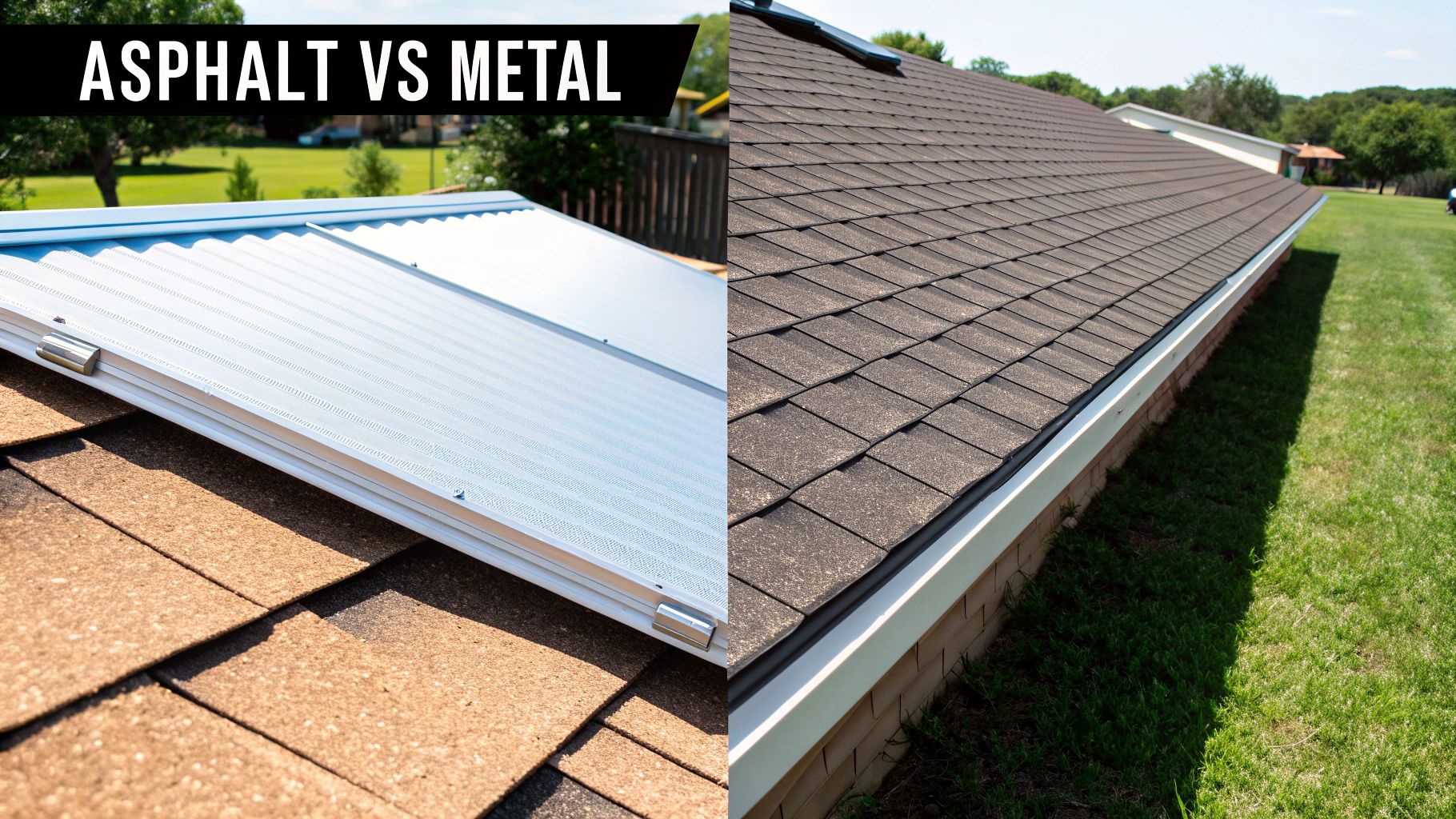
It’s one of the simplest but most important truths when you're trying to figure out the approximate cost of a new roof: where you live matters. A lot. The final price tag isn't just about the tiles you choose or the size of your house; your postcode plays a surprisingly big part.
Carry out the exact same roofing job on a terraced house in Surrey, and you can bet it will cost more than the same project in South Yorkshire or Wales. This isn't just contractors plucking a number out of thin air. It’s a direct reflection of real-world economic differences across the UK, and understanding this from the start is crucial for setting a sensible budget.
The North-South Divide in Labour Rates
So, what’s the biggest culprit for this price gap? It all comes down to the cost of skilled labour. It’s no secret that wages and the general cost of living are significantly higher in London and the South East. This economic reality filters down into every trade, including roofing.
A top-notch roofer working in a high-cost area like Guildford will naturally have a higher day rate than a roofer based in Sheffield. This isn't about one being more skilled than the other; it’s purely down to local market forces. When you consider that labour can make up as much as 60% of the total project cost, even a small difference in those daily rates can quickly add hundreds, if not thousands, of pounds to the final bill.
This regional labour cost is a fundamental part of any quote you'll receive. It's the main reason why national "average costs" are just a starting point, and a tailored quote from a local firm like Evershield Roofing is the only way to get a true picture for your home.
A Practical Example: Surrey vs. South Yorkshire
Let's bring this to life with a real-world scenario. Imagine you need a new roof on a standard three-bedroom terraced house. The job needs the same number of concrete tiles, the same amount of underlay, and will take the same number of hours to complete.
- In Surrey: The quote will be higher. Why? The regional labour rates are steeper, scaffolding hire is often more expensive due to higher demand, and even the skip permit from the local council might cost more. The roofer's own business overheads are higher, too.
- In South Yorkshire: Labour rates are generally lower across the board. The costs for scaffolding and waste disposal are often far more competitive. All those savings are passed directly on to you in the final quote.
For the exact same work, the price difference could easily be 15-20% or more. A job that might cost around £5,000 in South Yorkshire could realistically be quoted at £6,000 or more in Surrey. The same logic applies to smaller jobs, which you can see in our guide to UK flat roof repair costs.
Local Supply Chains and Regulations
While labour is the main factor, it's not the only one. The cost and availability of materials can also vary by area. Although big suppliers operate nationally, how close you are to a major distribution centre can affect delivery charges, which get added to your bill.
On top of that, local council rules can introduce surprise costs. If your home is in a National Park, like the Peak District, or a designated Area of Outstanding Natural Beauty (AONB), like the Chilterns, you might face strict rules on materials. To preserve the area's character, you may be required to use specific, often more expensive, locally sourced slates or tiles. It’s another layer of cost dictated entirely by your address.
Getting Smart with Your Budget and the Rules
Figuring out the finances for a new roof goes well beyond just the price of tiles. It’s about being clever with your budget, making sure you’re on the right side of UK law, and knowing how to get a fair price from a contractor. A lot of homeowners get caught off guard by some of the legal bits and pieces that can add to the final bill.
One of the biggest ones to be aware of is energy efficiency. If you find yourself replacing more than 50% of your roof's surface, UK building regulations actually require you to bring your loft insulation up to the current standard at the same time. It might feel like another expense upfront, but think of it as a long-term investment that will start paying you back with lower energy bills year after year.
Timing is Everything: How Smart Planning Saves You Money
Beyond the regulations, a bit of savvy planning can genuinely save you a decent amount of cash. Just like any trade, roofing has its peak seasons. Come spring and summer, everyone wants their roof done, which means demand is high, waiting lists are long, and prices are often at a premium.
If your roof isn't leaking like a sieve and can wait a little, think about booking the job for the quieter autumn or winter months. Roofers are often a bit more negotiable on price during this "off-season" because they want to keep their crews working. Shaving off even 5-10% can make a real dent in the total project cost.
The single best thing you can do to get a fair price is to get several detailed quotes. This isn't just about hunting for the lowest number. It's about figuring out a realistic benchmark for what your particular job should cost in your neck of the woods.
It's also essential to get your head around local rules, including any building permit requirements for roof modifications. Getting this sorted before work starts is the best way to avoid expensive delays or, worse, potential fines later on.
Why You Should Always Get Three Quotes
Getting just one quote is like flying blind—you have no idea if it’s fair. Two is an improvement, but three is the sweet spot. It helps you instantly spot any red flags. A quote that seems too good to be true probably is (they're likely cutting corners somewhere), while an outrageously high one is just an attempt to overcharge you.
For the best results, here’s how to do it right:
- Ask for an Itemised Breakdown: Make sure every quote clearly separates the costs for labour, all materials, scaffolding hire, and waste disposal.
- Give Everyone the Same Brief: To compare apples with apples, give each roofer the exact same project specifications.
- Talk About Guarantees: Find out what kind of guarantees they offer on both their workmanship and the materials themselves.
Running through this process doesn’t just give you a clear picture of the market rate; it gives you real negotiating power. The approximate cost of a new roof can vary massively. In the UK, you might see prices from as low as £27 per square metre for a simple job, all the way up to £560 per square metre for high-end, specialist materials.
When you’re armed with this kind of knowledge, you can step into your roofing project with confidence, knowing you’re making a sound investment in your home. At Evershield Roofing, we pride ourselves on providing clear, detailed quotes that spell everything out, so you know exactly where your money is going.
How We Get You a Quote You Can Actually Trust
We know that a quote for a new roof can feel like a big, scary number. Our job is to break it down so it makes perfect sense. We believe a good quote is all about clarity, and that starts the moment we step onto your property for our no-obligation site survey.
This isn't just a quick glance from the pavement. It’s a proper, hands-on inspection where one of our seasoned roofers gets up close with your roof to figure out exactly what it needs. We’re not just measuring square meterage; we’re looking at every single element that makes up a healthy, durable roof that will protect your home for decades.
What We Look for During Our On-Site Survey
We’ve seen it all over the years, which is why our process is so thorough. It’s the only way to give you a quote that won’t suddenly balloon with unexpected costs halfway through the job. We hate surprises as much as you do.
During our visit, our roofer will take a close look at:
- The Roof's Bones: We’ll check the state of the timber structure and battens underneath your tiles. Is there any rot, woodworm damage, or sagging? These issues have to be fixed before a new roof goes on.
- What's Up There Now: We'll identify the current tiles or slates and assess their condition. This helps us plan for a safe and tidy removal process.
- Chimneys and Leadwork: The chimney stack and its lead flashing are classic weak spots for leaks. We inspect the brickwork, pots, and all the flashing to make sure it’s sound.
- Your Roofline: We’ll also assess the fascias, soffits, and guttering. Sometimes they’re in great shape, but other times they need replacing to properly support the new roof.
This detailed, real-world assessment means our quote is based on facts, not a finger-in-the-air guess.
Choosing a local roofer who knows the building styles and planning rules across Buckinghamshire and the nearby counties makes a huge difference. You're not just buying materials; you're investing in local expertise and genuine peace of mind. We know what to expect from properties in this area, which means we can provide a quote you can truly rely on.
From Our Findings to Your Quote
After the survey, we don't just send you a single lump sum. We take all our findings and turn them into a clear, itemised quote where you can see exactly where your money is going.
We’ll break down the costs for materials, labour, scaffolding, and skip hire, and we're always happy to explain why each part is necessary. It’s this straightforward, professional approach that builds trust and helps you feel confident you're making the right decision for your home. Let's get you that honest, accurate quote and put you back in control.
Your New Roof Questions, Answered
Even with all the numbers crunched, a few nagging questions often pop up when you're considering a roof replacement. It's a big job, after all. Here are the straightforward answers to the queries we hear most often from UK homeowners.
How Long Will a Roof Replacement Take?
This is usually one of the first things people want to know. For a typical three-bedroom semi-detached house, you can expect the whole job—from the scaffolding going up to the final site tidy—to take between 2 and 4 days.
Of course, that’s just a guide. A larger detached property or a roof with a complicated layout, particularly if you’re using natural slate, might stretch closer to a week. And let’s not forget the famously unpredictable British weather, which can always throw a spanner in the works! We’ll always give you a realistic, upfront timeline with our quote so you can plan accordingly.
Will I Need Planning Permission for My New Roof?
For most homeowners, the answer is a simple no. If you're just re-roofing your home with materials that look similar to what’s already there, you won't need to get tangled up in planning applications. This applies to the vast majority of roof replacement projects.
That said, the situation is entirely different if your home is a listed building, is located in a conservation area, or falls within a National Park. In these cases, you absolutely must get consent from your local council before starting any work. When in doubt, it always pays to check first.
Does a New Roof Come with a Guarantee?
It certainly should. A guarantee isn't just a nice-to-have; it's a fundamental sign of a professional, trustworthy roofing company. Any new roof installation should provide you with two layers of protection.
First is the workmanship warranty from your chosen roofer, which covers the quality of their installation. Secondly, you should get a manufacturer's warranty that covers the roofing materials themselves. At Evershield Roofing, for instance, our guarantees are insurance-backed, giving you complete peace of mind.
What Should a Proper New Roof Quote Include?
A single, vague number on a piece of paper should set alarm bells ringing. A good, transparent quote will be fully itemised, showing you exactly where your money is going.
At the very least, you should expect a clear breakdown of:
- Labour costs for the roofing team.
- All materials, from the main tiles down to the smallest fixings and underlay.
- Scaffolding hire, erection, and dismantling.
- Skip hire for the proper disposal of old roofing materials.
- Any extra costs for things like chimney repairs or replacing fascias and soffits.
A detailed quote like this means no nasty surprises down the line.
Tackling a full roof replacement can feel daunting, but you don't have to navigate it on your own. For a clear, honest, and detailed assessment of your roofing needs in Buckinghamshire and the surrounding areas, trust the experts at Evershield Roofing. Get your free, no-obligation quote by visiting us at https://www.evershieldroofing.co.uk today.

